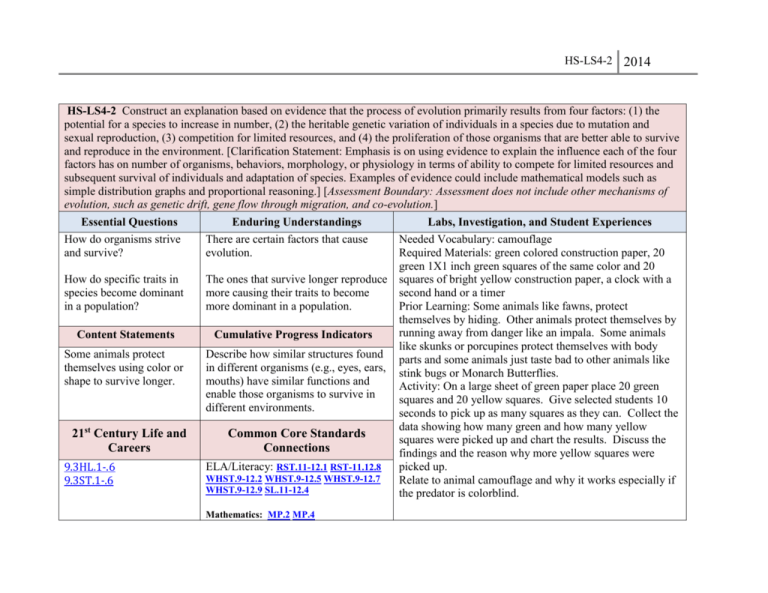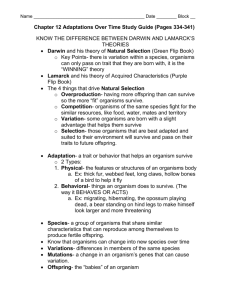HS-LS4-2 2014 HS-LS4-2 Construct an explanation based on
advertisement

HS-LS4-2 2014 HS-LS4-2 Construct an explanation based on evidence that the process of evolution primarily results from four factors: (1) the potential for a species to increase in number, (2) the heritable genetic variation of individuals in a species due to mutation and sexual reproduction, (3) competition for limited resources, and (4) the proliferation of those organisms that are better able to survive and reproduce in the environment. [Clarification Statement: Emphasis is on using evidence to explain the influence each of the four factors has on number of organisms, behaviors, morphology, or physiology in terms of ability to compete for limited resources and subsequent survival of individuals and adaptation of species. Examples of evidence could include mathematical models such as simple distribution graphs and proportional reasoning.] [Assessment Boundary: Assessment does not include other mechanisms of evolution, such as genetic drift, gene flow through migration, and co-evolution.] Essential Questions How do organisms strive and survive? Enduring Understandings There are certain factors that cause evolution. How do specific traits in species become dominant in a population? The ones that survive longer reproduce more causing their traits to become more dominant in a population. Content Statements Cumulative Progress Indicators Some animals protect themselves using color or shape to survive longer. Describe how similar structures found in different organisms (e.g., eyes, ears, mouths) have similar functions and enable those organisms to survive in different environments. 21st Century Life and Careers 9.3HL.1-.6 9.3ST.1-.6 Common Core Standards Connections ELA/Literacy: RST.11-12.1 RST-11.12.8 WHST.9-12.2 WHST.9-12.5 WHST.9-12.7 WHST.9-12.9 SL.11-12.4 Mathematics: MP.2 MP.4 Labs, Investigation, and Student Experiences Needed Vocabulary: camouflage Required Materials: green colored construction paper, 20 green 1X1 inch green squares of the same color and 20 squares of bright yellow construction paper, a clock with a second hand or a timer Prior Learning: Some animals like fawns, protect themselves by hiding. Other animals protect themselves by running away from danger like an impala. Some animals like skunks or porcupines protect themselves with body parts and some animals just taste bad to other animals like stink bugs or Monarch Butterflies. Activity: On a large sheet of green paper place 20 green squares and 20 yellow squares. Give selected students 10 seconds to pick up as many squares as they can. Collect the data showing how many green and how many yellow squares were picked up and chart the results. Discuss the findings and the reason why more yellow squares were picked up. Relate to animal camouflage and why it works especially if the predator is colorblind. HS-LS4-2 2014 Modifications (ELLs, Special Education, Gifted and Talented) Desired Results Sample Assessments Define phylogeny. 1. history of evolution of organisms (tree diagram). 2. the order of Taxa. 3. a two part key used to identify organisms which is based on a branching series of choices. Based on visible physical features. 4. the science of classify and naming organisms. In order for differences to occur in a population, must happen and be exhibited in phenotypically. (variation) Structures as different as human arms, bat wings, and dolphin flippers contain many of the same bones. These bones have developed from very similar embryonic tissues. How do biologists interpret these similarities? Select all that apply. 1. by identifying the bones as being homologous structures 2. by the principle of convergent evolution 3. by proposing that humans, bats, and dolphins share a common ancestor Morphological divergence is to morphological convergence is to 1. disruptive selection; directional selection 2. homologous structures; analogous structures 3. allopatric speciation; sympatric speciation 4. dimorphism; polymorphism as . · Teacher tutoring · Peer tutoring · Cooperative learning groups · Modified assignments · Differentiated instruction · Native language texts and native language to English dictionary · Response to Intervention (RTI) www.help4teachers.com and www.docstoc.com , (search tiered lesson plan template · Follow all IEP modifications/504 plan Text: Holt, Rinehart and Winston: Modern Biology May 13, 2002 Essentials of Anatomy & Physiology (4th Edition) Jan 13, 2006 by Frederic H. Martini and Edwin F. Bartholomew Campbell Biology (9th Edition) Oct 7, 2010 by Jane B. Reece and Lisa A. Urry HS-LS4-2 2014










